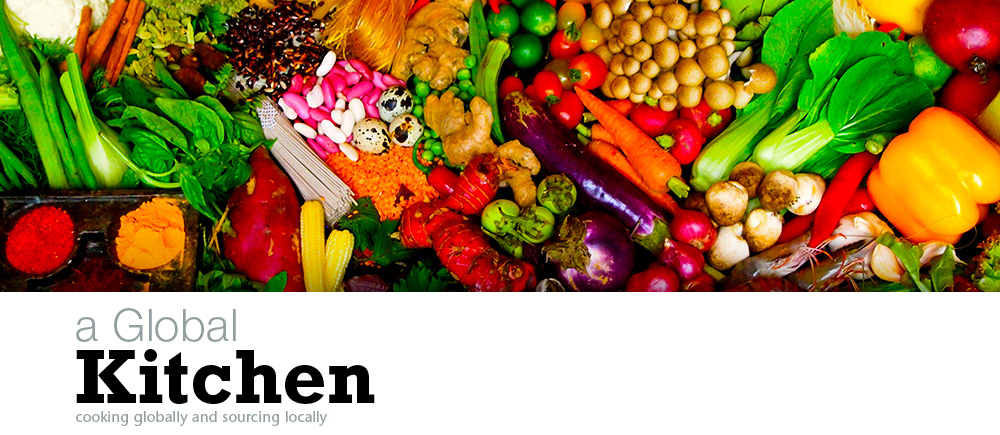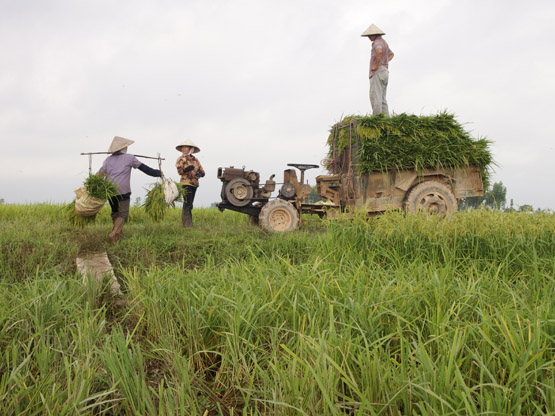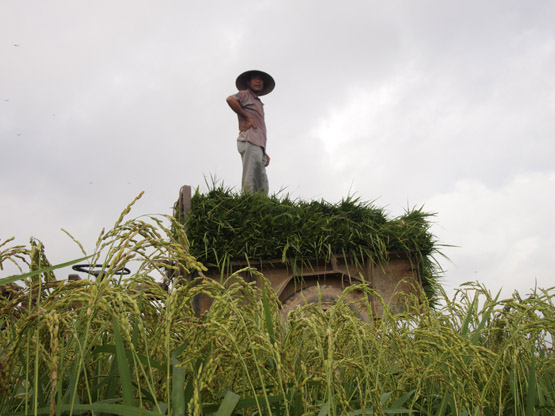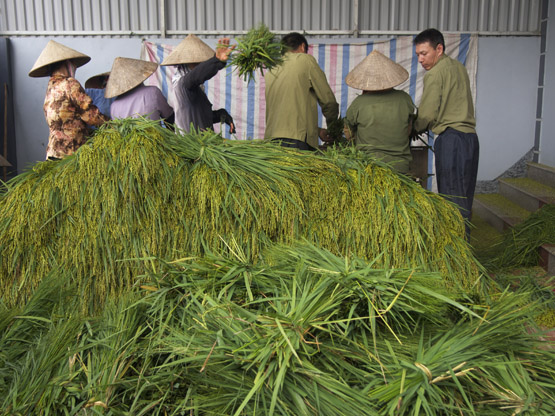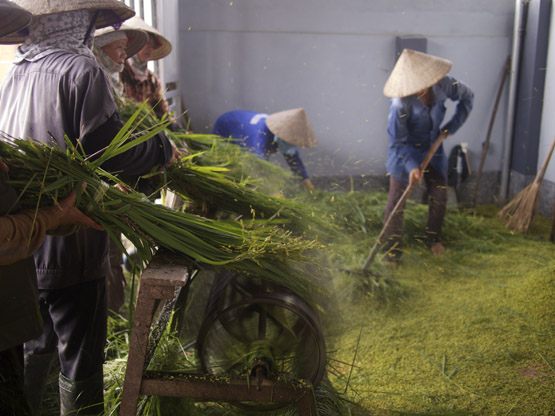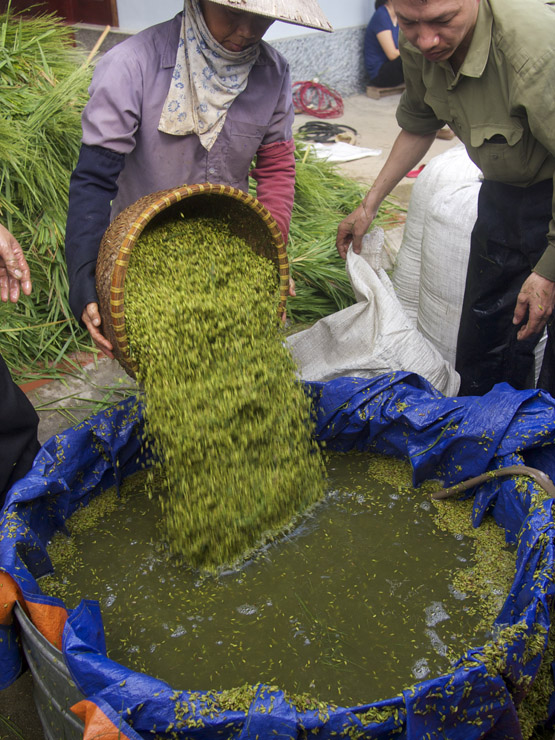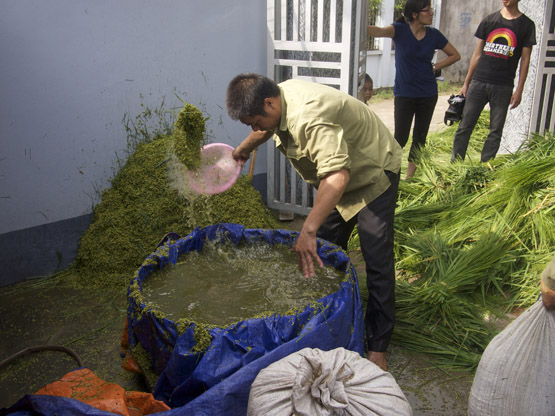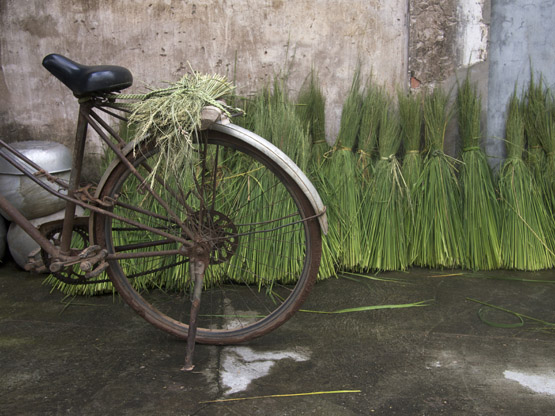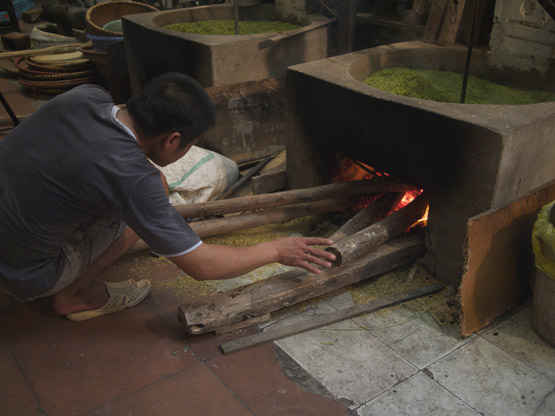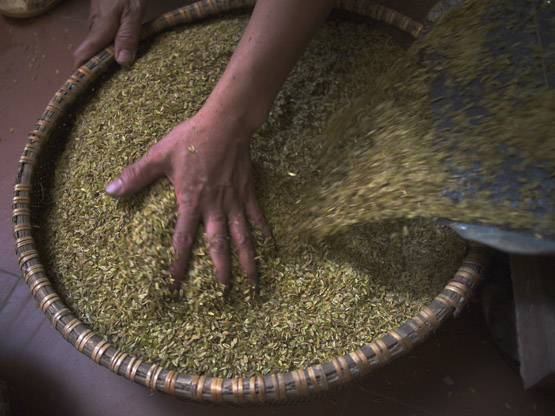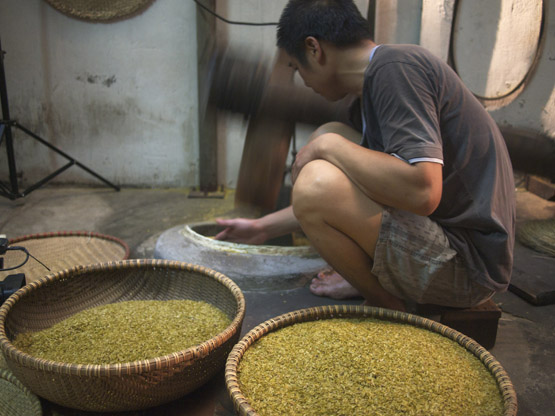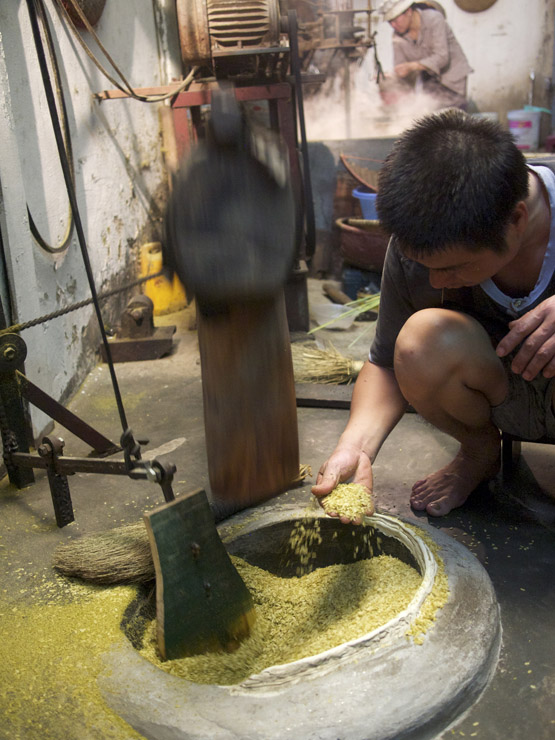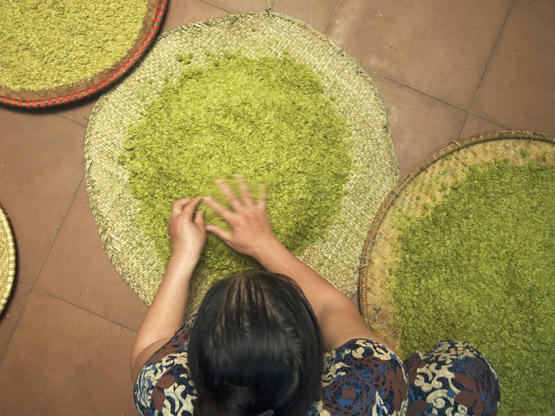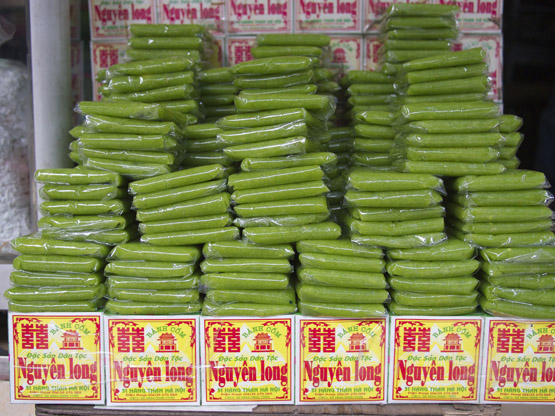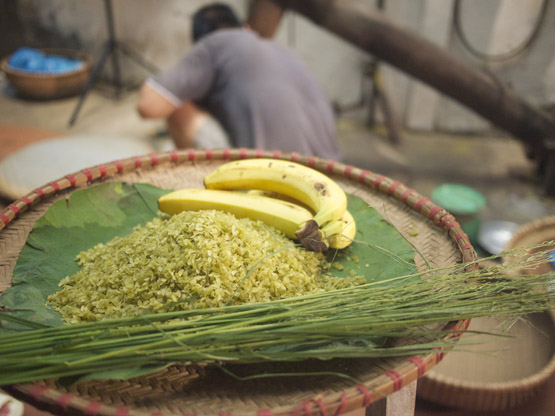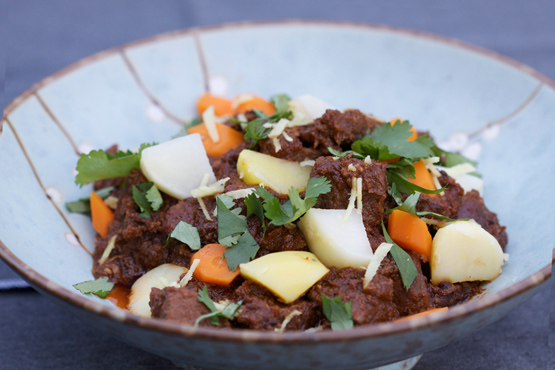A quick glance at the fruits and vegetables stacked in the baskets of roaming food vendors in Hanoi reveals what season it is. Now in early autumn, you can find a couple handfuls of such vendors wandering the streets of Hanoi’s Old Quarter or settled on the sidewalk to sell a favorite Hanoi fall snack called cốm or young green sticky rice. Cốm is favored by Hanoians for its subtle fresh nutty sweet flavor and fragrance.
I was recently invited by a Vietnamese television show to experience a taste of autumn in Hanoi. We shot over three days on the streets sampling sour autumn fruits like ambarella and dracontomelon (quả cóc and sấu chín) tossed with a sugar, salt, chili mixture; collecting then preparing a dish using lotus seeds from the lotus pond near my house; learning how young sticky rice is transformed into com, fragrant flat jade colored flakes; and then onto a local restaurant to make a few autumn dishes that incorporate the young green rice.
My day harvesting, threshing, roasting and pounding the rice was a delight and I shot some photos to record the entire process how cốm is made from start to finish.
The unripen rice is harvested each year from August to October. When farmers see the rice stalks beginning to bend and a pressed grain releases a milky droplet of moisture they know it is time to begin the harvest.
I drove about 50 kilometres outside of Hanoi to a village and met some farmers in one of their fields. Arriving just around 5am I noticed the farmers busy at work and had been for some time as a quarter of the rice stalks of the approximately 30 X 40 metre field were already cut. They waved at me to join them in the harvest. The thin sharp sickles were not hard to use but Chi Mam showed me exactly where to cut, about 15cm (6 inches) from the base of the plant. After a couple hours of being hunched over slicing the stalks we took a short and much needed break eating sticky rice with mung beans for our breakfast. In typical fashion they asked my age, if I was married and did I have kids. They giggled as they found it funny that I could answer those basic questions in Vietnamese but then produced a blank expression as their questions became more detailed and I wasn’t exactly sure what they were asking. I switched the conversation back to the rice and the female farmers explained that this work tends to be done by women as the rice is not as heavy when unripen (compared to when fully ripe) and it allows the men to perform other chores.
A few of us began to load the tractor with the cut rice stalks as a couple others finished harvesting the field. Although just 8am the sun shone brightly and with such strength I understood why this laborious work begins so early in the morning. They encouraged me to climb on top of the pile of rice stalks and ride through the village to Chi Mam’s house just a few kilometres away. I got some bemused looks by their neighbors unsure of what to make of the situation.
The stalks were unloaded and then the husbands and wives teamed up to thresh, wash and pack the grains. I was amazed at the grip and efficiency of the electric threshing machine. Moving at such a high speed you need to delicately move the bunch of stalks over the drum. Pressing too hard can shave off more of the stalk than required.
The washing helps to separate the hollow grains and remove any unwanted parts of the stalk. These are kept and fed to the pigs. The grains are then loaded into 50 kg bags and three of these heavy bags are expertly balanced on the backs of motorbikes and driven to Vong Village 30 kilometres away an now within the city limits of Hanoi. Traditionally the families of Vong village would grow, harvest and then process the grains but as an urban village they no longer have any land to grow the rice and must purchase the rice from other farmers. Only about ten families in the village remain who hold the knowledge and maintain the tradition of processing the unripen rice grains into fragrant chewy jade rice flakes.
I made my way to the home of Ba Hai, the family matriarch who has been making cốm for over 40 years. She and her son guided me through the process. The roasting, husking and pounding used to all be done by hand but each family has been creative in mechanizing the process while retaining the key elements that produce the well-loved cốm.
The roasting of the grains starts early around 4am and heat quickly surrounds the room. I thought working on the line in a busy kitchen is sweat producing but this wins hands down. They move the wood around to maintain a constant heat and use a mechanical arm to keep the grains constantly moving and to prevent them from becoming too dark or burning. If overcooked the final rice flakes will not retain their beautiful shade of green. The grains are roasted for about 90 minutes and are ready when the roaster judges that they retain a malleable sticky firmness and remain flat when pressed.
The roasted grains are left to cool and then passed through a machine 3-4 times to separate the rice from the husks and to begin the process of being slightly pressed. The discarded husks are used to start the fires for the roasting of the grains but generally they are sent back to feed the pigs.
The rice is then pounded using a large wooden mortar and pestle contraption until it is sufficiently flat. The flakes are then raked by hand to separate any clumps.
Hanoians can purchase freshly made cốm in autumn from vendors on the streets who are identified by the rice stalks attached to their baskets. Some vendors will sell two or three types of cốm based on freshness: made that morning to a week or so old. The cốm is wrapped in a bunch in two different leaves, first lá dáy and then lotus leaves and stored in a fridge to keeps fresh.
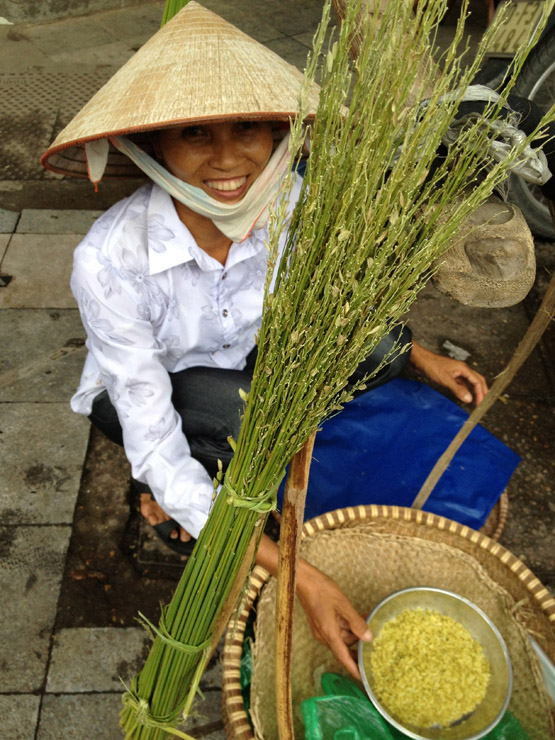
Look for the green rice stalks tied or lying on the basket as indication vendor will be selling cốm.
Dried cốm can be purchased year round from shops on Hang Than street as it is used in different events such as wedding ceremonies or on ancestral alters.
Cốm can be used as an ingredient in spring rolls, to make che (a sweet dessert), in ice cream (at 35 Trang Tien street) as a coating (like bread crumbs) on shrimp (Andrea Nguyen of Viet World kitchen has a nice recipe) or blanched pumpkin slices or simply accompanied with fall fruit (banana/ persimmon) or a simply eaten on its own.
